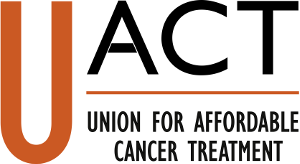Time for cancer patients to come before corporate profits
by Manon Ress, co founder and acting director of UACT
First posted by MOHGA KAMAL-YANNI ON JUN 15TH, 2017 IN ACCESS TO MEDICINES, INEQUALITY, NON COMMUNICABLE DISEASES, UNIVERSAL HEALTH COVERAGE
http://www.globalhealthcheck.org/?p=1973
On 26th Of May, the World Health Assembly adopted the long debated Resolution on Cancer Prevention and Control. This is an important step towards supporting countries to address this disease in order to achieve Universal Health Coverage (UHC).
Cancers are a leading cause of morbidity and mortality worldwide, with approximately 14 million new cases and 8.2 million cancer-related deaths in 2012, 70% of which occurred in low and middle income countries. These numbers are expected to increase as society ages and lifestyles change, particularly in developing countries. The societal cost, as measured by human potential loss and economic cost, is high.
In addition to prevention efforts, addressing cancer requires access to prevention and treatment but this goal cannot be achieved under the existing policies that shape the price of medicines.
Breast cancer is the most common cancer in women both in developed and developing countries. Women with positive gene “human epidermal growth factor receptor 2” (HER2) face serious challenges related to the high prices of two effective medicines.
Trastuzumab is marketed by Roche under the brand name Herceptin. In South Africa, a 12-month course of trastuzumab costs approximately ZAR 516,700 ($38,000) – or around 5 times the country’s average household income. Given its unaffordability, trastuzumab is not available in South Africa’s public health sector where more than 80 percent of the country’s population seek care. Moreover, high co-payments required by medical insurers to access treatment are simply unaffordable for many who use the private sector”.
When the patient is able to get Herceptin, the cancer can go into remission and treatment can be stopped. But if treatment is delayed and the cancer spreads, the medicines have to be used for much longer, which can eventually lead to resistance to trastuzumab.
The second medicine is a new trastuzumab combination called T-DM1 has saved the lives of many women, including myself. T-DM1 is also marketed by Roche as ‘Kadcyla’. Since its first registration, Kadcyla has generated more than $2.7 billion in sales for Roche.
T-DM1 is extremely expensive; I have received bills that range from $ 3,000 to $ 5,000 per week. The price in the UK was initially around £90,000. The high price meant that NICE did not recommend it to be prescribed by the NHS in England. According to the European Society for Medical Oncology, access to T-DM1 is limited in 30 of 48 European and Central Asian countries. It is expected that access to these medicines is even more limited in developing countries. In fact none of the 56 new medicines registered with the US Food and Drug Administration to treat cancer between 2010 and 2016 are on the WHO Model List of Essential Medicines-partly because of the high price.
The ever-increasing prices of cancer medicines are “justified” by the need for incentives to reward and induce private sector investments in R&D. However, funding R&D via high medicine prices results in rationing medicines and thus in unnecessary suffering and even death. This is neither morally acceptable nor economically sound. Achieving the targets of universal health coverage and of equitable access to safe and quality treatments for all requires reforming the R&D system in radical ways.
Firstly, governments need to implement new policies that put patients’ health before companies’ profit. Governments must move toward different ways of funding R&D that do not lead to high prices such as direct public funding and prizes for inventions. This was one of the recommendations of the UN High Level panel on access to medicines.
The Union for Affordable Cancer Treatment (UACT) proposes that a coalition of countries place a percentage of treatment budgets or GDP into an innovation fund. Funding can then be allocated to a combination of direct funding, subsidies, interim prizes, end product prizes, and rewards for openly sharing knowledge, data, materials and technology.
This proposed Cancer Innovation Fund would promote innovation that results in affordable prices of medicines without making trade-offs between access and innovation.
